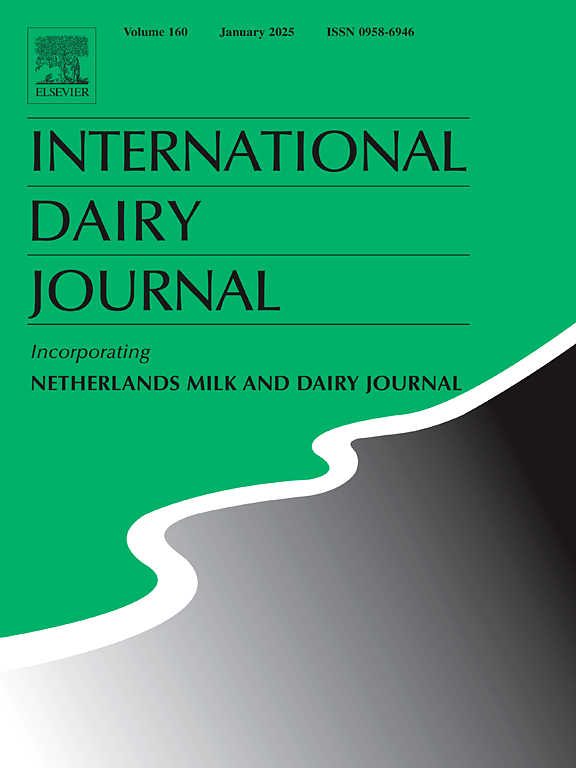放牧与全混合日粮(TMR)饲喂奶酪对中年超重成年人循环脂肪酸浓度的影响
IF 3.4
3区 农林科学
Q2 FOOD SCIENCE & TECHNOLOGY
引用次数: 0
摘要
与黄油相比,尽管奶酪的饱和脂肪酸(SFA)含量较高,但乳制品基质被认为是奶酪具有降低胆固醇作用的原因。与全混合饲料(TMR)饲养的奶牛相比,牧场饲养的奶牛所产奶酪中不饱和脂肪酸的含量更高。在 58 名体重超重的中年成年人中,以每天 120 克的剂量食用 6 周后,牧草喂养奶酪与全混合饲料喂养奶酪相比,循环中的总不饱和脂肪酸含量明显较低(总脂肪酸含量为 -3.87 ± 1.09 vs -2.69 ± 0.79 %,P = 0.038)。牧草喂养奶酪与 TMR 喂养奶酪相比,山嵛酸(C22:0,P = 0.015)和α-亚麻酸(C18:3 n-3,P = 0.004)的下降幅度更大。但是,经过 Bonferroni 校正后,这些差异不再显著。干预组之间没有观察到其他差异,包括血液胆固醇浓度。有必要进一步研究更长的持续时间和不同的剂量。本文章由计算机程序翻译,如有差异,请以英文原文为准。
The effect of pasture-fed vs total mixed ration (TMR)-fed cheese on circulating fatty acid concentrations in middle-aged, overweight adults
The dairy matrix is thought to be responsible for the cholesterol-lowering effects of cheese compared to butter, despite having a high saturated fatty acid (SFA) content. Cheese derived from pasture-fed cows has been shown to have increased concentrations of unsaturated fatty acids, compared to cheese derived total mixed ration (TMR)-fed cows. In n 58 middle-aged, overweight adults, circulating total SFA were significantly lower following consumption of pasture-fed vs TMR-fed cheese (−3.87 ± 1.09 vs −2.69 ± 0.79 % total fatty acids, P = 0.038) after 6-weeks when consumed at a dose of 120 g/day. Behenic acid (C22:0, P = 0.015) and α-linolenic acid (C18:3 n-3, P = 0.004) decreased to a greater extent following pasture-fed vs TMR-fed cheese. However, these were no longer significant after Bonferroni correction. No other differences were observed between the intervention groups, including blood cholesterol concentrations. Further work with a longer duration and different doses is warranted.
求助全文
通过发布文献求助,成功后即可免费获取论文全文。
去求助
来源期刊

International Dairy Journal
工程技术-食品科技
CiteScore
6.50
自引率
9.70%
发文量
200
审稿时长
49 days
期刊介绍:
The International Dairy Journal publishes significant advancements in dairy science and technology in the form of research articles and critical reviews that are of relevance to the broader international dairy community. Within this scope, research on the science and technology of milk and dairy products and the nutritional and health aspects of dairy foods are included; the journal pays particular attention to applied research and its interface with the dairy industry.
The journal''s coverage includes the following, where directly applicable to dairy science and technology:
• Chemistry and physico-chemical properties of milk constituents
• Microbiology, food safety, enzymology, biotechnology
• Processing and engineering
• Emulsion science, food structure, and texture
• Raw material quality and effect on relevant products
• Flavour and off-flavour development
• Technological functionality and applications of dairy ingredients
• Sensory and consumer sciences
• Nutrition and substantiation of human health implications of milk components or dairy products
International Dairy Journal does not publish papers related to milk production, animal health and other aspects of on-farm milk production unless there is a clear relationship to dairy technology, human health or final product quality.
 求助内容:
求助内容: 应助结果提醒方式:
应助结果提醒方式:


